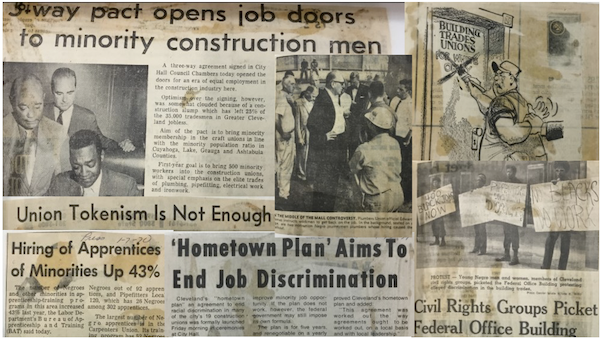This is the first in a series of articles that examines the use of community benefit agreements [CBAs] as a tool to achieve more inclusive and equitable development. Part 2 will compare CBAs in various cities - including Detroit, Chicago, Atlanta, Los Angeles, and Cleveland - and discuss the strengths and weaknesses of the different agreements. The series will conclude with an assessment of best practices and lessons learned in pursuing democratic citizen participation and achieving equity in the construction industry and development.

A collage of clippings of headlines and pictures from Cleveland-based newspaper articles — housed at Construction Employers Association — about civil rights protests for equity in the trades and minority participation on construction projects.
The Origins of Community Benefits Agreements
For several decades communities, including in Cleveland, have organized for Diversity, Equity, and Inclusion (DEI)1 in labor, entrepreneurship, and development. These efforts date back to abolitionist movements – protests to end slavery – and the Civil Rights Movement, during the 1950s – 1960s, where citizens organized to end Jim Crow laws in the South and de jure segregation2 across the United States.
Citizens also organized for community engagement in urban planning decisions due to low-income communities and communities of color experiencing little benefit and often even negative outcomes (e.g., displacement and neighborhood demolition) from top-down urban planning programs and practices, such as urban renewal.
These movements led to the government creating legislation that prohibits discrimination and promotes equal rights for all citizens regardless of race/ethnicity, etc., such as the Civil Rights Act, Equal Employment Opportunity, as well as Nixon’s Executive Order establishing the Office of Minority Business Enterprise (OMBE).3 In addition, the government implemented “bottom-up” decision-making practices, like Model Cities programs, and funding Community Development Corporations (CDCs) where residents have greater control over the urban planning process.
Unfortunately, these initiatives often fall short, and communities must continue to organize for DEI in all facets of life. Community Benefits Agreements (CBAs), like Cleveland’s Memorandum of Understanding4, are one of the latest tools communities use to organize for a seat at the table and participate in the development process, and to increase access to economic opportunities for minority-owned businesses and workers of color (e.g., advancing equity in the trades, local hiring5, etc.).
What is a CBA?
A CBA is defined as “a legally enforceable contract, [traditionally] signed by community groups and a developer, setting forth a range of community benefits that the developer agrees to provide as part of a development project.”6 In theory, the typical agreement is intended to be participatory, enforceable, transparent, and to hold developers accountable.7 The main benefits include local hiring, long-term career jobs, broad-based economic growth opportunities for disadvantaged individuals (e.g., apprenticeship/training programs, right to collective bargaining) and minority and women-owned business enterprises (MWBEs), affordable housing, and funding for other social services/programs and environmental issues like green space.
CBAs normally occur in larger cities with economic growth potential and on substantial projects, such as entertainment venues and multifamily development, which offer developers public subsidies and tax breaks. While CBAs are typically organized retroactively on a project-by-project basis, increasingly local governments are implementing community benefits ordinances or models where the needs of the community are no longer an afterthought [The effectiveness of these types of agreements will be discussed in Part 2 of this series].
CBA Process
The CBA process includes the following steps [The process is flexible, not chronological]:
|
Step One: Investigate |
Step Two: Community building and organizing (build coalition) |
Step Three: Negotiate CBA |
Step Four: Monitoring, implementation, and enforcement |
|
research information about the project, legal issues, constructing CBAs, community demands |
strategize campaign by identifying key players, building capacity, public outreach and education, creating messaging, taking public action |
assemble a negotiation team that is representative of all views of coalition and community members; coalition negotiates with developers and other relevant parties, including working with intermediary (often local government); process is inclusive and representative; create strong CBA that benefits and meets the needs of the community |
hold all parties accountable to do their part to meet CBA requirements; reporting and process is transparent |
Adapted from City Bureau8 and the Annie E. Casey Foundation9
Origins of the national CBA movement
The LA Live CBA, negotiated in Los Angeles in the early 2000s, was the first CBA that prompted a national movement of approximately 350 CBA campaigns in well over 100 cities, as of September 2021.10 The LA Live project, an entertainment complex, was built between 2005 – 2010 by Anschutz Entertainment Group (AEG), at a cost of $4.2 billion. AEG received approximately $545 million in public subsidies for the project.11 A coalition of labor (e.g., service sector and building trade unions) and community groups (e.g., Latino non-profit organizations, religious institutions, etc.) was formed to seek benefits from the developers, such as local hiring, affordable housing, and funds for parks and recreations. 12 The labor-community coalition wanted to ensure they would benefit from taxpayer funded development rather than experiencing negative outcomes, such as when construction of the Staples Center, adjacent to LA Live displaced roughly 200 residents in the late 1990s. The developers did meet the CBA requirements, but there was unfortunately a lack of transparency in reporting due to limited funding for continued monitoring.13
Overall, the CBA was a win for the community because it benefited from the project and had a seat at the negotiating table. The LA Live CBA example demonstrates the significance of using CBAs in development to correct past injustices, gain inclusion in the decision-making process, and ultimately benefit from projects that impact neighborhoods.
• • •• • •
Athena Nicole Last is a Ph.D. Candidate, Department of Sociology at Syracuse University studying CBA campaigns in the Rust Belt region. This email address is being protected from spambots. You need JavaScript enabled to view it. her This email address is being protected from spambots. You need JavaScript enabled to view it..
_______
1 DEI is defined as the “symbiotic relationship, philosophy and culture of acknowledging, embracing, supporting, and accepting those of all racial, sexual, gender, religious and socioeconomic backgrounds, among other differentiators” (Dunn 2020). Dunn, Lisa. 2020. “What is Diversity, Equity & Inclusion (DEI)?
InclusionHub, November 6. https://www.inclusionhub.com/articles/what-is-dei.
2 “De jure segregation” - governmental laws and decisions that directly authorized institutional segregation as well as enabled and supported “de facto segregation,” prejudicial and discriminatory acts by individuals and private agencies - that divided communities along unequal racial lines. Rothstein, Richard. 2017. The Color of Law: A Forgotten History of How Our Government Segregated America. New York, NY: Liveright Publishing.
3 The Minority Business Development Agency (MBDA), previously known as OMBE – which assists minority-owned businesses in building capacity, access to capital, and other opportunities to spur economic growth – became a permanent office with the passage of Infrastructure Investment and Jobs Act under the Biden administration.
4 Cleveland’s “Memorandum of Understanding Regarding Community Benefits and Inclusion” or what is often referred to as Cleveland’s MOU, was signed by various stakeholders in 2013. The goals of the MOU include a workforce demand study, developers who agree to MOU must make good faith efforts to meet MWBE and local hiring targets, pre-apprenticeship and full-apprenticeship programs, workforce and MWBE reporting, mentor-protégé relationships, and a Construction Diversity and Inclusion Committee.
5 Local hiring is defined as contractors being required to use a certain percentage of workers or work hours from a geographic location, often a low-income community or community of color. The Infrastructure Investment and Jobs Act now allows local hiring provisions on federally-funded infrastructure projects.
6 Gross, Julian, Greg LeRoy and Madeline Janis-Aparicio. 2005. “Community Benefits Agreements. Making Developmental Projects Accountable.” Los Angeles, CA: Good Jobs First and the California Public Subsidies Project. http://www.goodjobsfirst.org/sites/default/files/docs/pdf/cba2005final.pdf.
7 Janseen-Jannsen, Leonie B., and Menno van der Veen. 2017. “Contracting communities: Conceptualizing Community Benefits Agreements to Improve Citizen Involvement in Urban Development Projects.” Environment and Planning A 49(1):205-225. doi:10.1177/0308518X16664730.
8 Campos, Alma, Sarah Conway, and Phoebve Mogharei. 2022. “Will that New Development Benefit Your Community?: The People’s Guide to Community Benefits Agreements & Alternatives.” City Bureau, February. http://www.citybureau.org/cba.
9 The Annie E. Casey Foundation. 2007. “The Community Benefits Agreements: The Power, Practice, and Promise of a Responsible Redevelopment Tool.” https://assets.aecf.org/m/resourcedoc/aecf-communitybenefitsagreements-2007.pdf
10 Interview with John Goldstein, founder of the Coalitions, Campaigns and Community Benefits, in September 2021
11 Ho, William. 2008. “Community Benefits Agreements: An Evolution in Public Benefits Negotiation Processes.” Journal of Affordable Housing & Community Development Law 17(1/2):7-34. http://www.jstor.org/stable/25782802.
12 Saito, Leland, and Jonathan Truong. 2015. “The L.A. Live Community Benefits Agreement: Evaluating the Agreement Results and Shifting Political Power in the City.” Urban Affairs Review 51(2) 263:289. doi:10.1177/1078087414527064.
13 Marantz, Nicholas J. 2015. “What do Community Benefits Agreements Deliver? Evidence from Los Angeles.” Journal of the American Planning Association 81(4): 251–267. doi:10.1080/01944363.2015.1092093.
___













